|
Size: 22187
Comment:
|
Size: 22903
Comment:
|
| Deletions are marked like this. | Additions are marked like this. |
| Line 5: | Line 5: |
| == October 8, (Friday) == * During the morning Andrea looked at the time line and spectra on Camadia, and Robert processed data from the previous night. Independently from each other they informed us that these data were too noisy and unstable to be affected only by sky noise, indicating something was going really wrong with the instrument. Andrea immediately saw that this excess noise was due to one of the Pulse Tube head that was transmitting vibrations to the instrument. |
|
| Line 8: | Line 11: |
| * In the morning Andrea and Alain (remote) worked on acquisition and found that the tone power parameters were not implemented correctly the previous day, which could explain that some KID were not very sensitive. They fixed the problem. '''Number of resonances now identified on each array:<<BR>> array 1: 1062<<BR>> array 2: 580<<BR>> array 3: 1045'''<<BR>> |
* In the morning Andrea and Alain (remote) worked on acquisition and found that the tone power parameters were not implemented correctly the previous day, which could explain that some KID were not very sensitive. They fixed the problem. '''Number of resonances now identified on each array:'''<<BR>> '''array 1: 1062''' (with typically ~40 bad ones during observations on Camadia monitoring)<<BR>> '''array 2: 580''' (with typically 4 bad ones during observations on Camadia monitoring)<<BR>> '''array 3: 1045''' (with typically ~35 bad ones during observations on Camadia monitoring)<<BR>> |
Back to the NIKA2 run 5 main page
Contents
- October 8, (Friday)
- October 7, (Friday)
- October 6, (Thursday)
- October 5, (Wednesday)
- October 4, (Tuesday)
- October 3, (Monday)
- October 2, (Sunday)
- October 1, (Saturday)
- September 30, (Friday)
- September 26, (Monday)
- September 25, (Sunday)
- September 24, (Saturday)
- September 23, (Friday)
- September 22, (Thursday)
- September 21, (Wednesday)
- September 20, (Tuesday)
- September 19, (Monday)
- September 2016, 18 (Sunday)
- September 2016, 17 (Saturday)
- September 2016, 16 (Friday)
- September 2016, 15 (Thursday)
October 8, (Friday)
- During the morning Andrea looked at the time line and spectra on Camadia, and Robert processed data from the previous night. Independently from each other they informed us that these data were too noisy and unstable to be affected only by sky noise, indicating something was going really wrong with the instrument. Andrea immediately saw that this excess noise was due to one of the Pulse Tube head that was transmitting vibrations to the instrument.
October 7, (Friday)
In the morning Andrea and Alain (remote) worked on acquisition and found that the tone power parameters were not implemented correctly the previous day, which could explain that some KID were not very sensitive. They fixed the problem. Number of resonances now identified on each array:
array 1: 1062 (with typically ~40 bad ones during observations on Camadia monitoring)
array 2: 580 (with typically 4 bad ones during observations on Camadia monitoring)
array 3: 1045 (with typically ~35 bad ones during observations on Camadia monitoring)
- Then Andrea left, and Robert went back down to Granada; good progresses made on IMBFITS. Significant portion of the day spent investigating what happened the previous night and finding explanations. Progresses on Pipeline (Nico working remotely) to find another new better pix ref. During observation on sky fix a little problem that made disappear most of the RTA logbooks of the previous days.
On sky: our goal was again a pointing session using the new ref pix... but the atmosphere was against us.... and the cryostat (see next day, Oct 8)... 1) instrument check and skydips. 2) focus XYZ. 3) Beammap. 4) Tests on nkpoint subscan duration on pretty strong quasar that we don't see well => duration doesn't help for the cross scan; but number of subscan might once data processing can co-add ? Sky is not good but still, on previous runs we could see much better these quasars in worse sky conditions => something is fishy here... (see Oct 8...). 5)Dark session. 6) Again focus XYZ, then tentative for pointing on various quasars, but with bad results. 7) skydip, then scans on TipCurrentAzimuth, first with window opened, then window closed for a dark tests comparisons.
October 6, (Thursday)
Robert and Charles came from Granada to the telescope. Progresses on many stuff during the day (PaKo, instrument, Pipeline, IMBFITS, etc. ; no need to enter into details here.)
On sky: 1) sky good enough to try optimizing KID parameters: point telescope to zenith, big frequency sweep to find as many resonances as possible (recovering some that were lost on the previous initial sweep), and optimising tones powers and attenuators ==> brand new parameters defined after ~3h work. 2) Defining a brand new kidpar is necessary: doing a beam map to identify again all the pixels and their numbers. 3) Choice of a new reference KID (pixel), point + XYZ focus centered on the new ref pix. 4) After skydip try starting a pointing session... Alas things went wrong: pointing quality not good, choice of a new ref pix, but still confusing results from the various maps concerning the pointing. After investigation the next day (Oct 7) here's a summary of what happened (for more details see TAPAS and Day to Day Logbooks):
Till scan 21 (Oct 7), everything looked coherent except that the signal on quasars seemed unexpectedly faint (but we might know why now, see explanation next day). After several scans with no source on the cross scans: re-focus and point on Uranus, things seemed in OK, so back to a strong quasar (scan 33). The source was 20 degree higher than the previous source in elevation: so as expected the position of the source rotated on the map (since the new ref pix is away from the center of rotation which is defined by the current pointing model, which itself was calculated for another ref pix during run 3). This explains why the fit was not correct on the cross: the kid ref passed on the side of the source in azimuth. Unfortunately for the observers it was a nkpointb for which the map fit on array 1 was bad also. They didn't though about or dare using the fit of the other arrays that were in fact correct. Changing manually the pointing offsets with various tries can't work. The next shift tried to pursue a bit pointing tries, but finally gave up and concentrated on skydip, beammap focus. After investigation the next day, all the session makes sense in terms of pointing values observed on the various scans; the offset of the ref pix with respect to the rotation axis and the fact that many pointing scans looked too faint brought confusion among some of us.
October 5, (Wednesday)
- Working on codes during the day (e.g. 2 Elvin instances in acquisition causing problems of creating double files, etc.)
On sky: 1) bad sky during several hours, dark session, 2) resonances lost after opening window shutter, frequency sweep per box to recover all, 3) spend significant time trying to figure out why the reference pixel maps are always 0 => turned out it was set in previous runs, but not in the kidpar derived from the previous days test sessions ! 4) choice of a new ref pix, tested on sky (pointing - focus), 5) reintroduce tune subscan to avoid tuning during the 1st subscan quite damaging for calibration scans like pointing, 6) X-Y-Z focus, 7) test new beam maps in 1 scan (99 subscan, then 140 subscan with new PaKo beta version), 8) FOV focus session, 9) beam maps session with out of focus ones, 10) pointing tests for Nico.
October 4, (Tuesday)
- Juan Macias, Samuel Leclercq, Ruth Evans, Jean-François Lestrade, Carsten Kramer and Laurence Perotto arrive at the telescope, Martino leaves.
- The cryostat is now at 178 mK. We are using the external nitrogen trap.
- 17h00 It is raining. No observations for the moment.
- 23h30 After a long optical alignment session we found a pretty good configuration by changing the nominal level and tilt in the cryostat (from Level=10, tilt=-1.7 to Level=9 tilt=0.5) and by changing the alignment of M5. The figure below summarize with schematics of the various mirrors centres the main steps and outcome of this alignment session:
On sky: 1) test arrays are alive, but pretty bad sky, 2) dark test, 3) skydips tests,sky improving, 4) pointing, focus, beam map (sky not good enough for improving array parameters), so get maps with current kidpar, 5) finish with quick dark session. Check the day to day logbook page for more details.
October 3, (Monday)
- Alessandro-remote 10h. I show here the noise measured in NIKA1.5 during run 30 on one of the feedlines of the 2mm array, before any optimisation
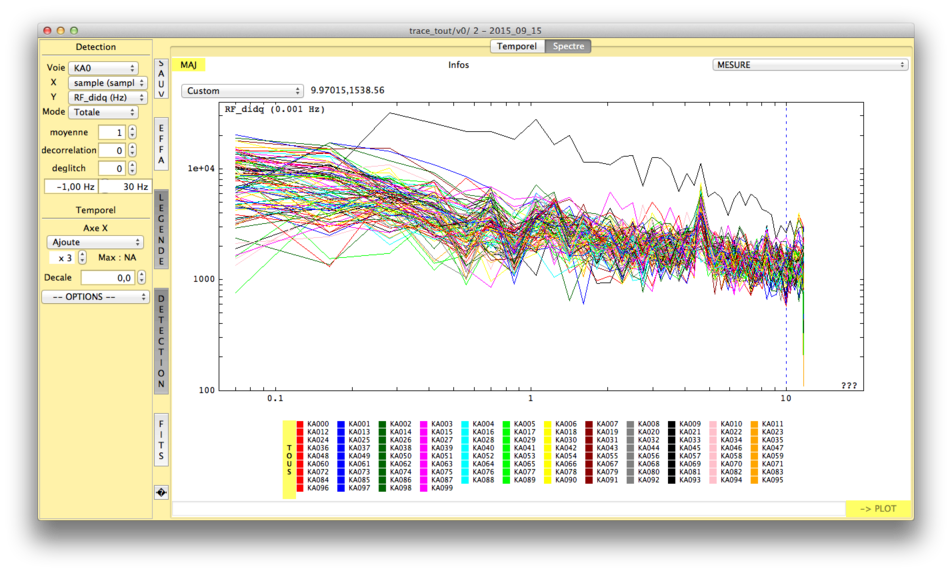
- 16h30. The pression of the gas just before the trap is high again. We stop the PTs to clean the mixture from air contamination and we mount the external nitrogen trap.
It is clear that the noise we got in NIKA2 is well comparable.
October 2, (Sunday)
- 14h00. The cryostat is cold again. We regulated the plate temperature at 175mK.
- 17h00. After recovering the resonances, we spent time to remove the additional correlated noise which was cleary present on the 2mm array. From our point of view it was related to a change of the pulse tube cold head position inside the cryostat. This position was regulated during the previous campaigns in order to minimize mechanical vibrations but it might have been changed by the opening of the cryostat. We regulated again and the noise is now strongly reduced (see plots below). After this, we spent some additional time to optimise the working point of the 2mm array in particular by adjusting the levels of each detector.
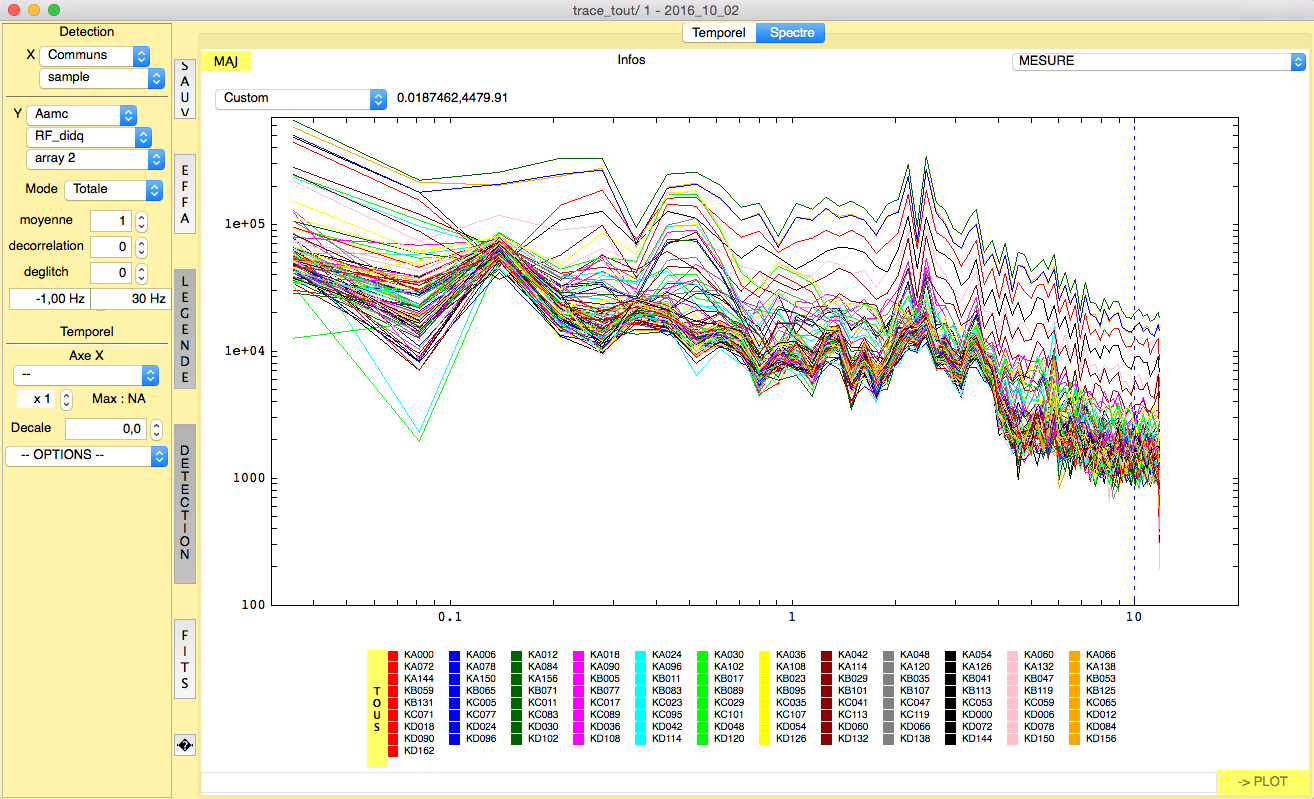 Before
Before 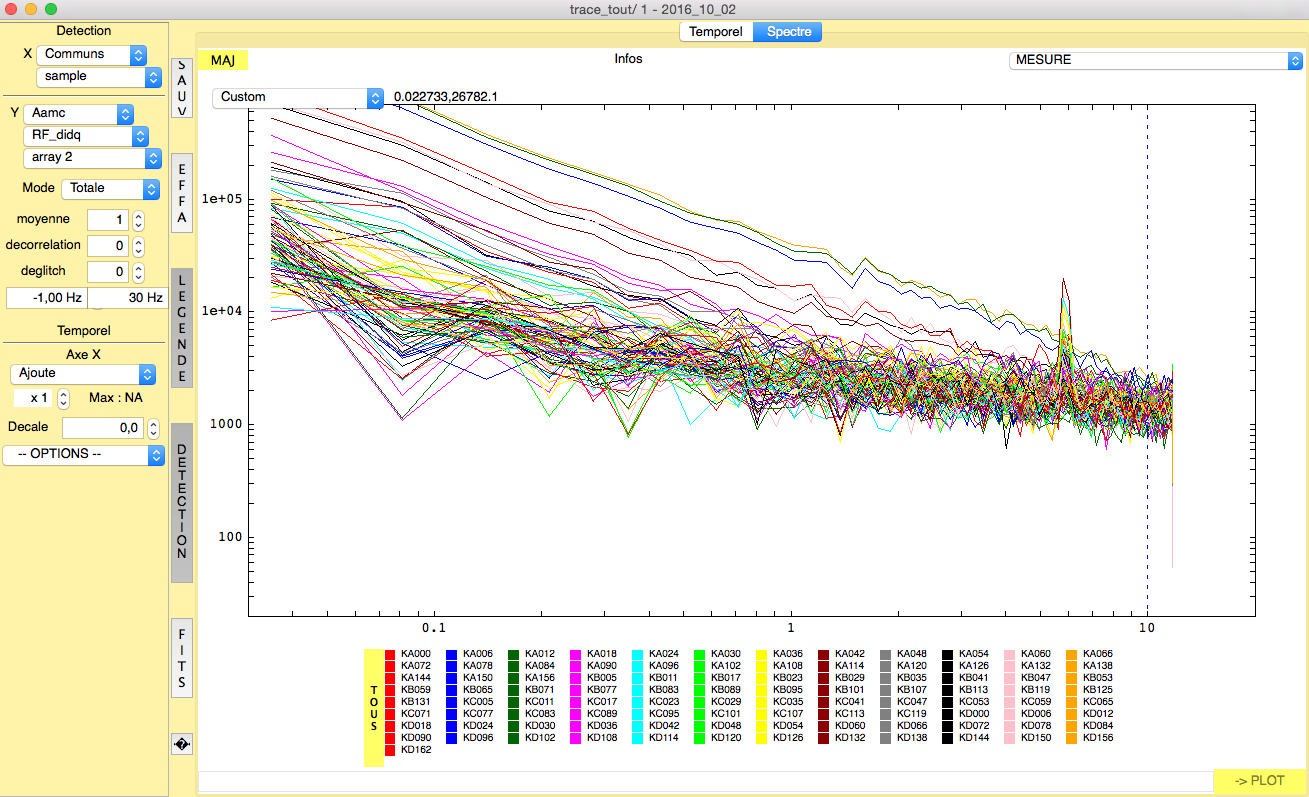 After regulation of the PT position
After regulation of the PT position 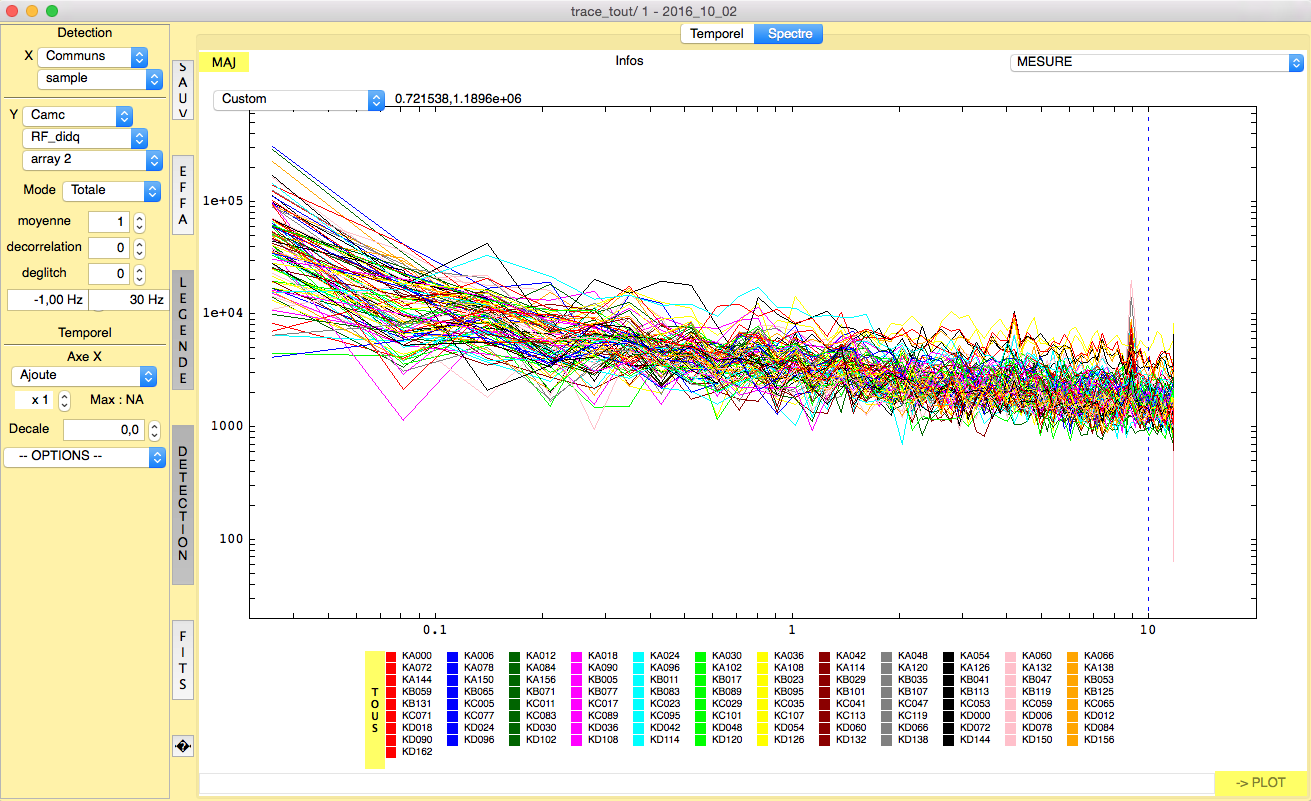 After optimisation of the detectors
After optimisation of the detectors
October 1, (Saturday)
- 11h00. The readout is installed at its nominal position. All the board are connected. the Acquisition starts correctly.
- 12h30. The temperature of the mixing chamber is quite stable at a temperature of 118mK!!!
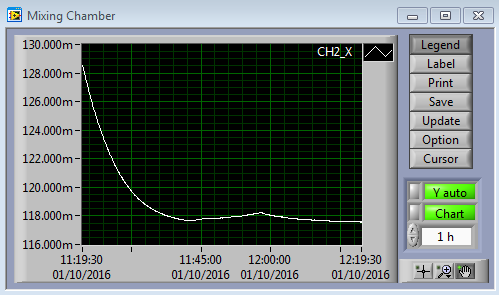
- 18h30. Pression of the gas just before the trap keep increasing. We decided to stop the PTs heat up the cryostat in order to be able to clean the mixture from air contamination. We should reach again the nominal temperature tomorrow at lunch time.
September 30, (Friday)
- 17h00. Martino and Andrea arrived at the telescope with 20 liters STP of 3He.
- 18h00. About 34mbar of 3He added in the mixture. This means that we used about 25% of the content of the bottle (about 5 liters STP). Now the content of the mixture should be similar to what we had in the beginning of the campaign before the 3He pump exploded. Start to condensate again, everything seems OK.
September 26, (Monday)
- 1h00. Observing. The cryostat is dying, strong oscillations of T on the still (0.3K peak-peak), the trap is the more and more blocked. Signal on Neptune at 2mm around 700Hz. Around 2500Hz on Uranus. Nut non-negligible opacity corrections to be expected (tau=0.3-0.4, EL=30-45 deg).
On the box L, we identify clearly the two populations of resonances: the illuminated and those in dark (dark array in series). See figure below, showing the 1/f of the atmosphere on the illuminated KID, and much less in the dark. The "much less" will be electronics of residual illumination ?
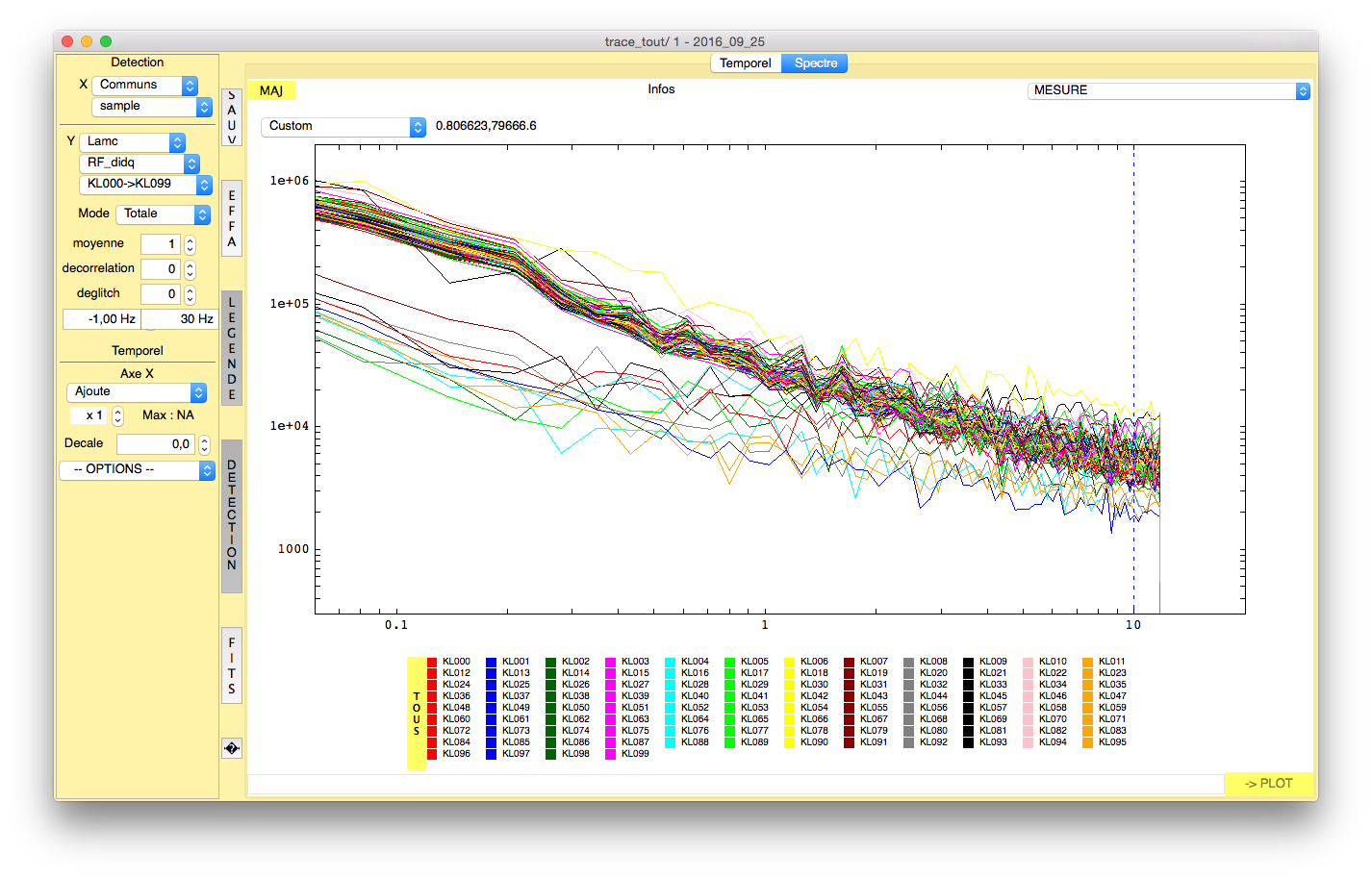
The good news is that the dark array doesn't seem to affect the performance of that box.
- 2h00. Stop observations. We have acquired mainly beam-maps and made focus et pointings. Tested a skydip. The mixture is recuperated with the PTs ON during the nught. As expected, we have 538mbar left.
- 8h00. Observing. Electronics dismounted and stored in the spiral room. Stop the PTs, wait it to be cold to clean before starting again.
September 25, (Sunday)
- 8h30. Temperature around 200mK. Reached 175mK during the night but the big trap is blocking also. Seems (hope) to be OK for today at least. Tomorrow, in view of the coming run, we have to warm up a bit and clean the traps. Working on trace now.
- 9h-12h. Difficult to produce the param file for the 2mm. The "resonances array 2" did not work properly. I did box-per-box and then added the OFF by hand on the file (!!). We have in total 580 KID and 36 OFF. Most of the KID are good despite we have a large correlated noise that in my opinion is related to the cryostat (270mK).
13h. Replaced AMC 179: #26 is replaced by #14. Done in the router. Still not working. IT MEANS THE PROBLEM IS IN THE SLOT OR THE RACK OR THE SOFTWARE ??? We start observing without the T. Looking back at an old ELOG entry (https://lpsc.in2p3.fr/elog/NIKA/314) I see that in fact the slot 9 of that rack didn't work properly. So THE MISTERY IS SOLVED, at the end of the first observation run at 17h I will change the position of that board and make a new param for Tamc.
- 14h. After all the mess in the last week we finally see the Sky. See Mercury (200Jy) below seen under tau 0.6 (at least) and EL=40DEG. S/N is above 1E4 assuming good decorrelation.
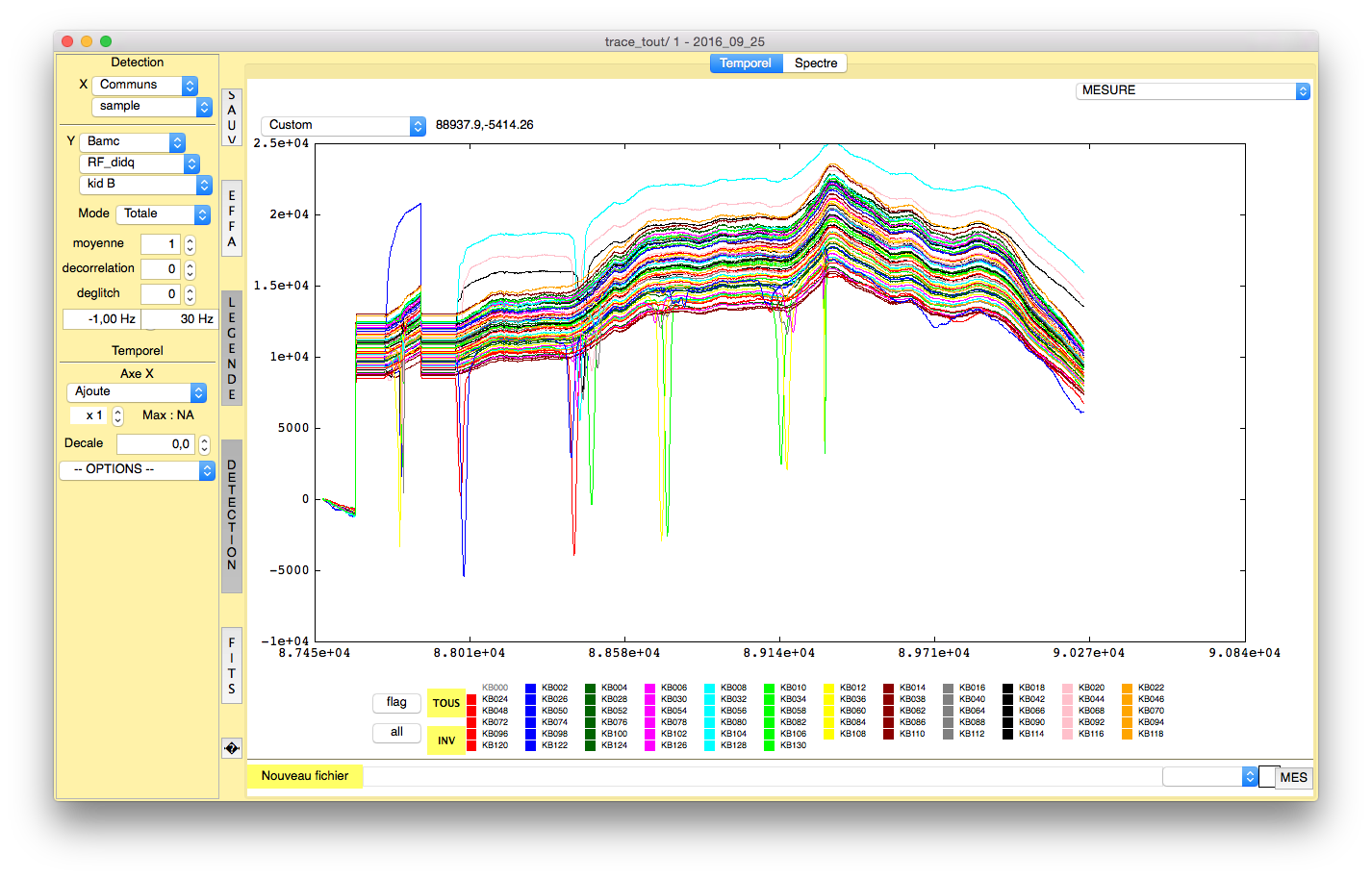
- Here a few preliminary plots. We started observing with (0,0) Nasmyth offsets, (0.0) pointing offsets and focusZ=0. The first map showed we were off-centered by about 20 arcsec. After a few failed files, we performed a focusOTF-Z sequence to optimize the focus a bit (based on last run's kidpar and array 1 geometry) before doing a beammap. We found that we had to observe at z=-0.5. Here are the plots of the focusOTF sequence to illustrate this, but with the kidpar that was derived later on the beammap (hence the 2mm map...). The FWHM are larger than expected, but the geometries are approximative at this stage, no pointing correction is applied, the weather was not excellent (see the beammap plots below), so... The beam is elliptical though.
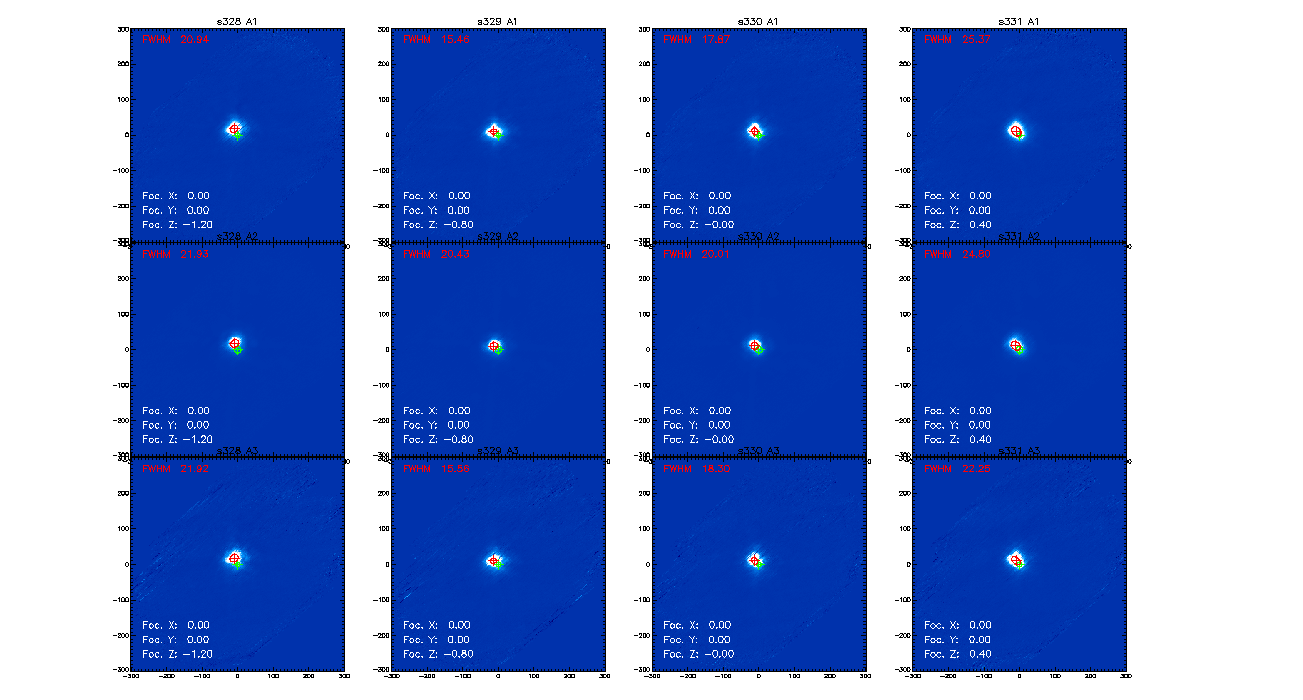
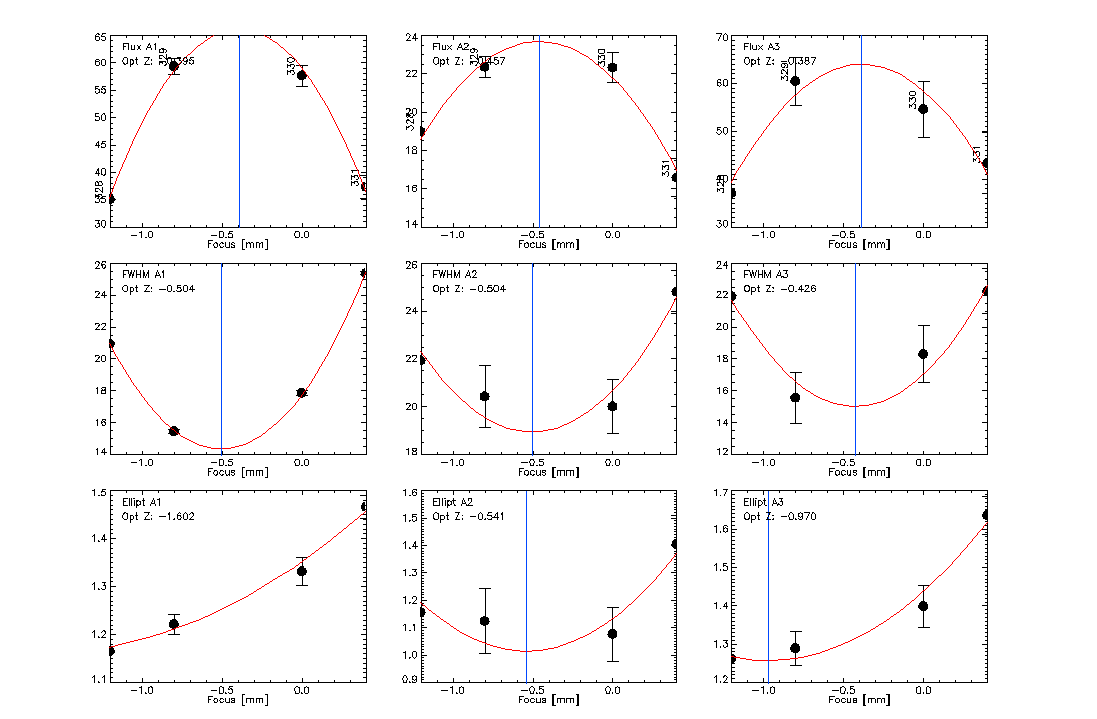
- Once the focus was as good as we could get, we did a beammap that allowed to derive the following offsets. See the lack of precision on the offsets due to instrument and weather conditions on the first plot. The second plot was derived during the evening session on Neptune with better resonnances and better weather:
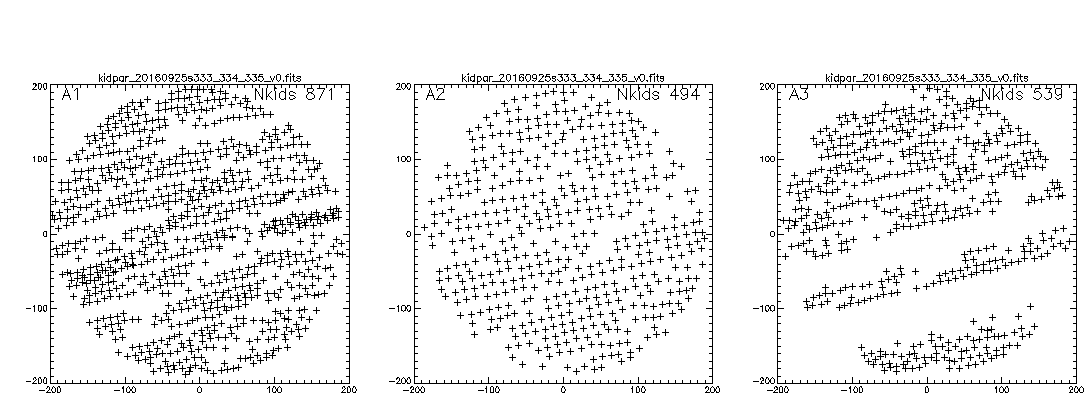
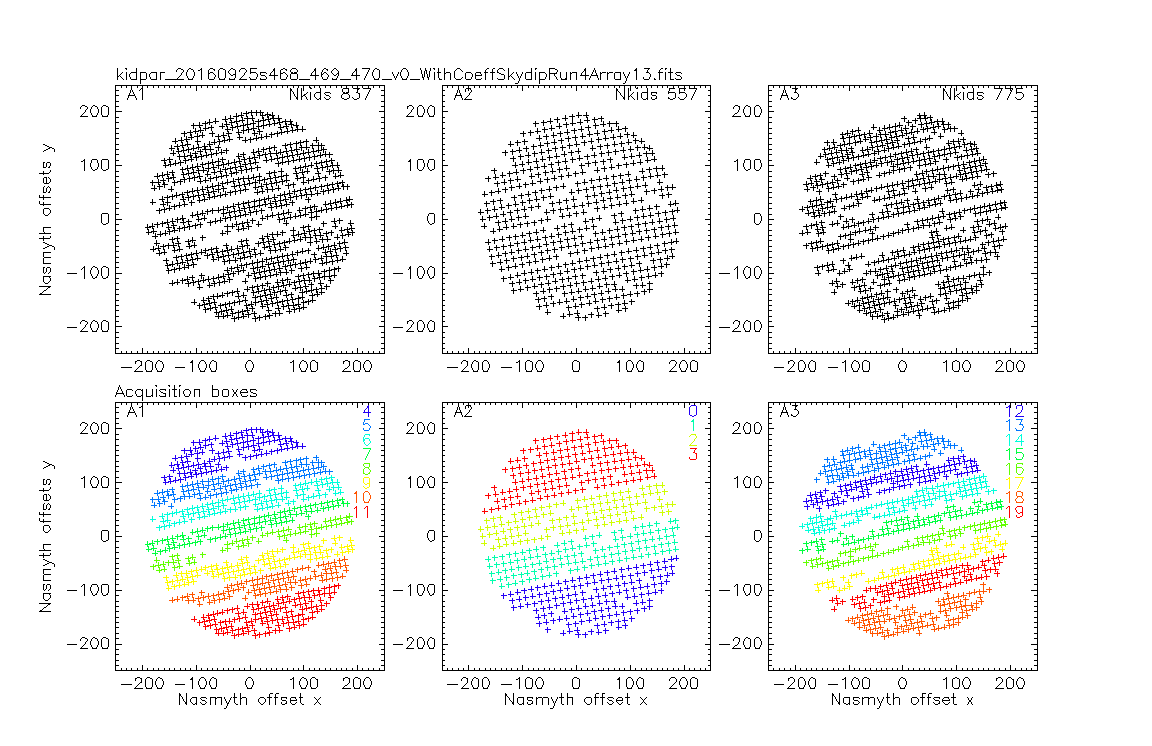
- Using the central beammap, we tested for desynchronizatino (a.k.a zigzag effect) between NIKA2 and the telescope. The plot shows, as a function of an artificial delay in msec, the distance between the centroids when only forward or backward scans are projected. The three matrices are synchronized to better than 1ms, the overall instrument shows a 14 msec delay with the telescope.
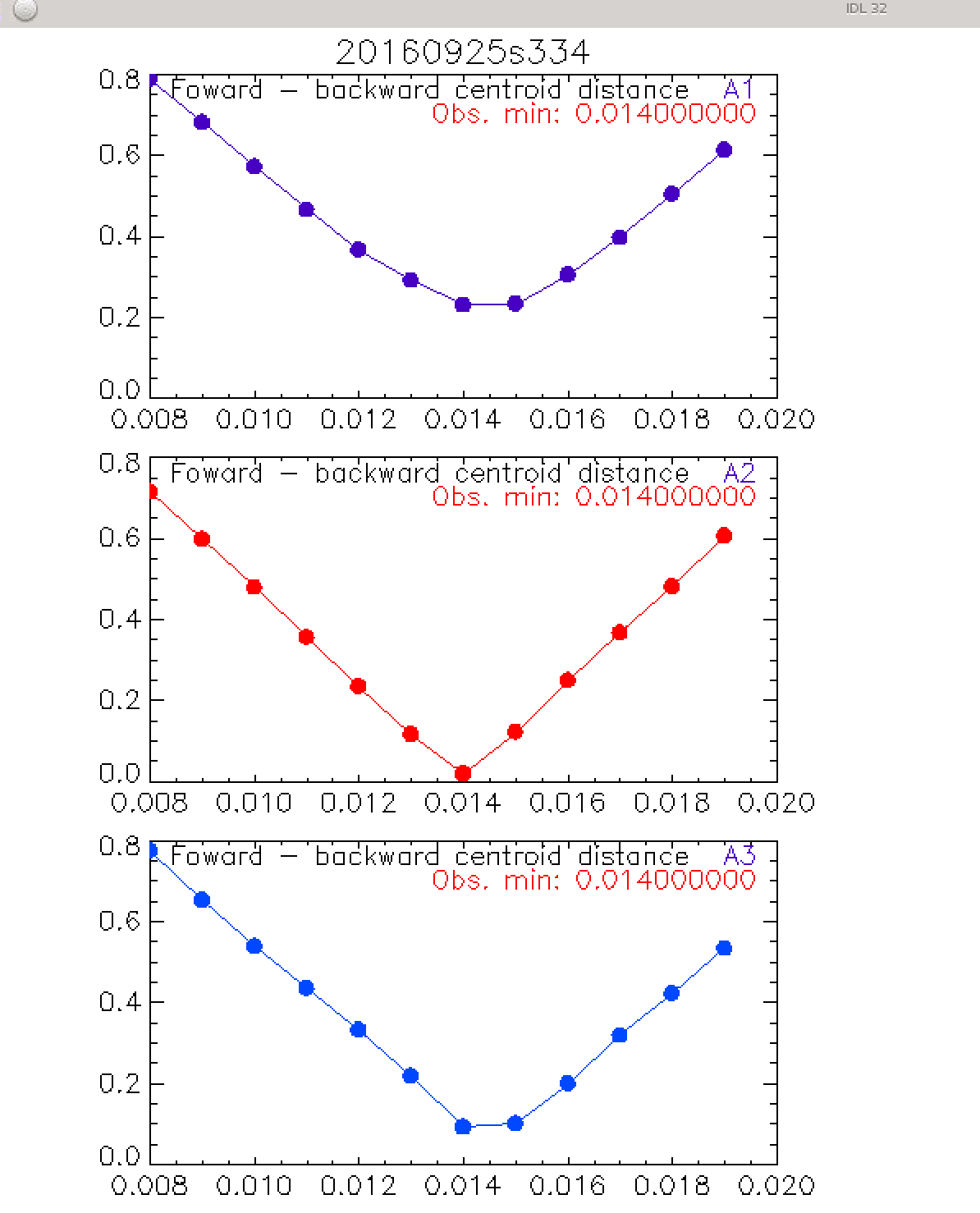
* We had a second session tonight, a few problems with files at the beginning but Juan and Alain solved the problem. The 2mm is better tuned than this afternoon. We made a few observations on Neptune, including a beammap and then moved to Uranus to perform another beammap in particular. We'll end the session by a short observation of MWC349 or a another calibrator to see if we already have hints on the FWHM difference between planets and less bright sources like we saw in the previous run.
September 24, (Saturday)
- At 10h the mixing chamber is around 15K, the condensation should start in a couple of hours if everything goes well. Plan then: check if the arrays are connected (while condensing), connect the 40 cables on the cryostat, test during the afternoon slot the system (SW, elvin etc.), then go on Sky tonight if we see the resonances.
- We have a 3 hour slot this afternoon, although not cold, we check scripts and the acqusition. Nico has produced two new pako scripts that he's happy to check. But for the resonnances that are not there, the online analysis IDL software is working fine.
* 13h30. Start condensation.
* 17h. Cold enough for us to check the feedlines. ALL THE 20 ARE CONNECTED !!!! Finally good news. However, we still wait to see which temperature the cryostat will reach. So far around 1.1K, still condensing the mixture in the trap.
* 20h. The small traps got blocked immediately. I switch to the big one. I have connected all the 40 cables on the cryostat.
* 22h. The good news is that the cryostat reached 300mK (still at 1.2K), enough to see the resonances and probably to acquire a geometry tomorrow. I try before the night to pump the helium remained trapped in the small trap that is blocked but not entirely. Done at 22h25, I re-condense the 50 mbars of mixture that are back into the reserve.
September 23, (Friday)
- Cryostat cooling down gently. A few problems with electronics and informatics. The readout boards lose the connection from time to time, more often when the tones are generated. Sometimes an entire rack switches off (usually rack 1 192.168.1.150). The "acqui" program stops when this happens. The nika2-a VNC on archeops8 stops from time to time.
- Written a script (linked on the nika2-a desktop) to launch all the instruments on nika2. When one stops better to launch everything again. To be confirmed. I also checked a bit the tones at the level of the cryostat and decided to change a bit the param to make them even flatter. Now the DAC levels are: 30,30,40,50,70.
September 22, (Thursday)
- T0+48h. T_mixing_chamber=162K; T_still=82K. T_4K_plate=35K. (was in run 1 at T0+48h: T_mixing_chamber=202K; T_still=104K. T_4K_plate=60K). This is explained by the fact that we started cooling down after the mixture washing, when the cryostat was already a bit cold.
September 21, (Wednesday)
- AB has submitted 3He via DHL to Granada.
- SN has contacted Linde-US to get green-light to order 20l 3He as spare for the future.
- T0+36h. T_mixing_chamber=205K; T_still=124K. T_4K_plate=62K. (was in run 1 at T0+48h. T_mixing_chamber=202K; T_still=104K. T_4K_plate=60K). This is explained by the fact that we started cooling down after the mixture washing, when the cryostat was already a bit cold.
September 20, (Tuesday)
- At 3h the cryostat is pumped from the air trapped. According to the pressure inside the big pipe 60-meters, we estimte that the volume of the pipe is half that of the reserve (17 mbars in the pipe correspond to 8 mbar in the reserve.
- At 3h15 starting the real cooldown. Let's hope this time. Later this morning we should add 3He.
- Olivier arrived at the telescope. He started to work on the electronics and assemble the crates.
- Another bad new: the Néel 3He stock bottle is empty! Alessandro got in contact with Alain in order to ship some 3He supply from Grenoble ASAP. In the meantime we put a bit more 4He in the mixture (from a high pressure bottle gas we had in stock) in order to continue the cool down. Cooling down to 1K is the longest part, until then the 3He is not absolutely necessary, so hopefully the 3He will arrive just when we need it.
- IRAM Granada started the process to order soon some 3He supply, 2 pumps (replacement of the broken one + a spare), and oil filters.
- The whole electronics is mounted and ready to be tested.
- After another small accident the amount of mixture is 454mbar. Added 87mbars of 4He, waiting for the 3He. So the total amount in P3 should now be, temporarily, around 540mbars. Plan to add 40mbars in 3He. The volume of the reserve is 135 liters (measured today, we had always thought it was 100 liters). So it means around 5 liters of 3He.
September 19, (Monday)
- Spent the whole day cleaning the mixture. Used the LN2 trap from NIKA2 mounted in series in the injection. A series of technical limitations made that the procedure has been slow. The final step was a preref in which the mixture circulated 1 hour below 70K (4K injection PT). From the original 606mbar we have now 484mbars. So we have lost around 120mbars, or 1/5 of the reserve. Could have been worse considering the nature of the problem we had. Tomorrow I'll add some mixture out of the Néel group stock and try to start the real cooldown.
In the meantime Martino continued working on the Turbo pump problem, and found its cause: the cable inside the Automate box which transfer the informations in and out of the pump controller, was in fact made from 2 cables soldered together, at the soldering junction some insulation layer was missing around the various wires contained in the cables, causing 3 of them to be in contact with each other. One is a ground, which must have entered in contact with the others while working on the MPPSYNC. Isolating the wires allowed to recover the control of the pump (and fix an old patch in the LabView program that had been necessary to write for a proper communication without knowing that it was the short cut between 2 wires that made it necessary).
- Martino and Johannes left with the CNRS truck in the afternoon.
September 2016, 18 (Sunday)
- Bad day: the 3He pump exploded (part of the chamber broke violently opening to air a sealed section and letting leak all its oil), most probably caused by an overpressure due to a blocked oil filter. We don't know how much 3He we lost, we're working hard to try to clean the He gas and circuitry from possible air contamination. At best the cool down of the cryostat is delayed by few days. At worst the run is cancelled.
- Before this big event, Martino and Alessandro were working on the communication problem with the 3He turbo pump. Martino found a way to communicate directly with the pump to switch it on and off, but impossible to change the speed. He was continuing investigating the problem, when the 3He pump exploded.
September 2016, 17 (Saturday)
- Finish mounting NIKA2 back in place. Everything went fine and smoothly, without problem.
- Start leak tests.
- Zemax simulations done. Ray tracing figures look scary, but it's the PSF that matters:
For the defect on the 1K lens: ~1/3 of the image surface is affected (top side); extra aberrations appear in the side lobes at ~10^-2 level, the beam peak decreases by up to 6%, the encircled energy at the 1st dark ring (-13dB level of Gaussian fit) decreases by up to 5% <=> the benefit of the corrugations AR effect is cancelled out for those pixels. It seems acceptable since most of the image is not or negligibly affected; we'll see on the sky with beam maps.
For the defect on the 2 100mK lenses: 80% of the image is affected (red cross shape); extra aberrations appear in the side lobes at ~5x10^-3 level, the beam peak decreases by up to 4.5%, the encircled energy at the 1st dark ring (-13dB level of Gaussian fit) decreases by ~3.7% <=> a significant fraction of the benefit of the corrugations AR effect is cancelled out, but not all. It seems acceptable.
- Fix a communication problem with the MPPSYNC instruments inside the Automat box (above NIKA2 on the side wall). But then the 3He turbo pump (side wall above NIKA2, below Automat) is not responding any more to any command.
September 2016, 16 (Friday)
- Arrival at the telescope of Samuel.
- Unload truck dismount NIKA2 nose, roll NIKA2 body it in the corridor.
- Dismount NIKA2 body, up to the cold stage optics.
- Change the 1K lens in the corridor: remove the smooth one, place the corrugated one. See a small defect that hadn't been seen before on a section of the new corrugated lens: groove ~5mm wide, ~0.1-0.3mm deep, ~5-7cm long. Probably acceptable; decide to keep the lens, Samuel will simulate the effect with Zemax.
- Change the 100mK lenses in the servo room (floor below the receiver cabin). Here also a small known defect on 2 of the 5 lenses: ridge ~0.5mm wide, ~0.3mm high, along 2 perpendicular diameters. Before coming Samuel estimated with a simplified simulation it was acceptable, he will simulate more accurately the defect.
- Change the 2mm array: replace the 1020 KIDs array with the new 616 KIDs array.
- Change the dichroic.
- Start mounting again everything together.
September 2016, 15 (Thursday)
- Arrival at the telescope of Johannes, then Alessandro, Martino and Aurelien with the truck.
